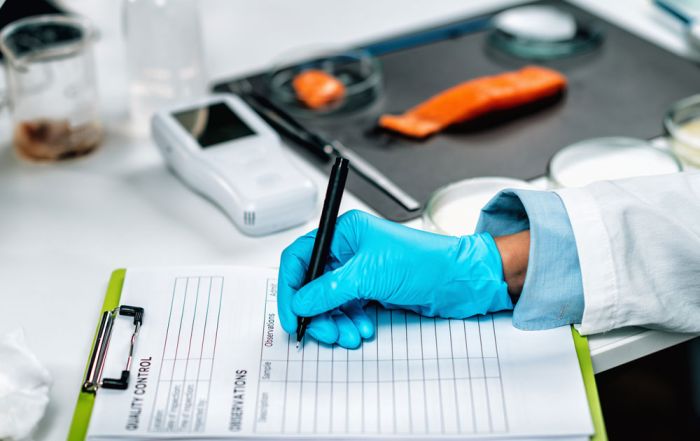Safely Shopping at Farmers’ Markets: A Food Safety Guide for Foodservice Operators and Chefs
Farmers’ markets are an appealing source of fresh, local, and seasonal ingredients for individuals and families across the United States. They also provide an excellent source of products for foodservice operators and chefs. Local farmers’ markets offer the opportunity to build relationships with local growers, reduce food miles, and bring fresh flavors to the plate. However, shopping at farmers’ markets for a commercial kitchen involves more than selecting the ripest tomato or the best watermelon; it requires a careful eye toward food safety.
One of the benefits of sourcing from farmers’ markets is the ability to speak directly with the people growing your food. Use this opportunity to ask about their food safety practices, including how the produce is harvested, washed, and stored; what the source of the water used for irrigation and washing is, and how livestock and produce areas are separated to avoid cross-contamination.
Further, inquire if the farmer participates in any food safety training or certification programs, such as the USDA’s Good Agricultural Practices (GAP) program. While GAP certification is not mandatory, it verifies that farms are following science-based guidelines to minimize the risk of microbial contamination during growing, harvesting, packing, and transporting food. Even if a grower is not certified, many adopt the practices, so it’s worth having an informed conversation.
…Many consumers think local means safer. And while you may know the grower and perhaps even the plot of land that a product comes from, it doesn’t necessarily mean that it is safer.
When selecting produce, keep an eye on the basic quality of the product, just as you would inspect the product if it were delivered from your broadline distributor. Is the skin or rind intact, with no visible mold, bruising, or decay? Observe the packaging and display areas. Are they relatively clean? Ensure that no produce is placed directly on the ground. Determine if there is a clear separation between raw animal products (e.g., eggs or meat) and produce to avoid cross-contamination. If dairy, eggs, or meats are sold, verify that they are held at safe temperatures with proper refrigeration or coolers.
After purchase, the safety of the product becomes your responsibility. Transport perishable items in coolers with ice packs or insulated containers. Always label and date products as you would with any other product in your business. Store items in separate containers to prevent cross-contamination between produce and proteins.
Although farmers’ markets may not offer the same level of documentation as large-scale distributors, traceability is still essential. Keep records of what was purchased, from whom, and on what date. Save receipts or take photos of vendor signs along with your purchases.
If your state or local regulations mandate that you use only approved or licensed sources, check with your local or state regulatory agency to ensure your farmers’ market purchases are compliant. Some local regulations require documentation for farm-sourced products used in commercial settings.
Last, but certainly not least, ensure your kitchen staff are trained on safe handling practices for locally sourced foods, which may not arrive in the same packaging or condition as commercial deliveries. Reinforce the importance of checking temperatures, washing all produce, and documenting sourcing. Develop a standard operating procedure for handling farmers’ market purchases or update your existing SOPs.
If you develop ongoing partnerships with local growers, consider encouraging them to pursue GAP certification or share their current food safety plans with you. Collaborating on food safety builds trust and contributes to a stronger local food system.
Many consumers think local means that the product is safer. And while you may know the grower and perhaps even the plot of land that a product comes from, it doesn’t necessarily mean that it is safer. By building relationships and applying the same due diligence to your local purchases as you do your other orders, you can bring the best of the farmers’ market to your menu with confidence and care. Risk Nothing.
READ MORE POSTS
Hot off the Press: The 2022 Model Food Code has been Released! Part One.
It has finally arrived! Yes, the new year has arrived – but I was not referring to it. I was referring to the new 2022 Model Food Code (10th edition) that has been released by the Food and Drug Administration. I thought I might take this blog and the next blog to discuss some of the changes that have been made to the Food Code that you might see coming your way in the next few years.
Is a Food Safety Culture on your New Year’s Resolutions List?
We hope you all had a wonderful Holiday season and are getting ready for a great new year!
Don’t Underestimate the Importance of Employee Health as we head into the Winter Months
Early this month, I ran across an article discussing an outbreak investigation in the Australian Capital Territory. The outbreak caused more than 200 people to fall ill and was one of the most widespread outbreak investigations in the history of the territory. The cause was traced back to Norovirus, a virus I am sure you have heard us opine about in this blog before.
Exclusion and Restrictions: Understanding Employee Health and the Food Code
I received a call earlier in the month from a foodservice operator who suspected that one of their employees may have fallen ill and wondered if they had to send the employee home for the day. Once I started to ask a few more questions, it became obvious that the operator wasn’t really in-tune with the food code requirements on restrictions or exclusions for employees who may not be feeling well. Given that most operations are dealing with staff shortages currently and the fact that we are about to head into the fall and winter – when we tend to see an increase in upper respiratory and other illnesses, such as the flu - it seemed like a very timely and important topic for the blog this month.










